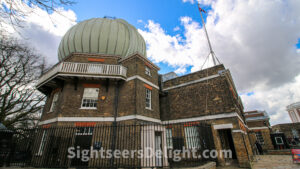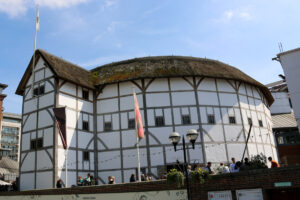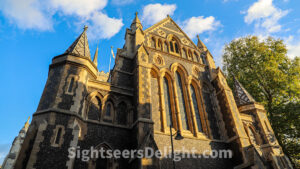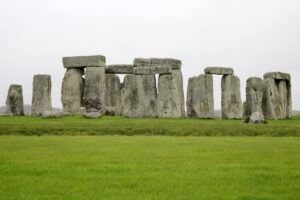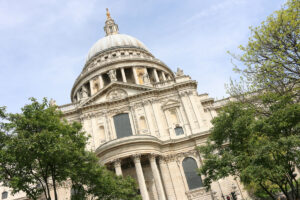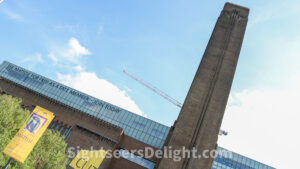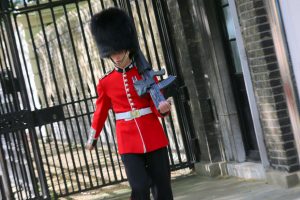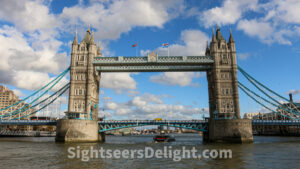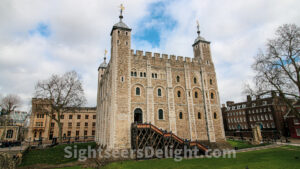The Royal Observatory Greenwich is part of Royal Museums Greenwich, which also includes the Cutty Sark. The Royal Observatory Greenwich is home to Greenwich Mean Time and the Prime Meridian and one of the world’s most important historic scientific sites. Since its founding in 1675, Greenwich has been at the center of time and space measurement. Visitors can stand on the historic Prime Meridian line.
Sally Lunn’s is a historical house located in Bath and is known to be the oldest house in the area dating back to 1482. Here, a young Huguenot baker named Solange Luyon, Anglicized as Sally Lunn, invented the first Bath bun in 1680. This regional delicacy, similar to a brioche bun, can be relished with sweet or savory toppings and is popular worldwide. Sally Lunn’s offers a menu based on this famous bun during the day and serves fine English cuisine in the evening. Additionally, visitors can explore the original kitchen used by Sally in the downstairs kitchen museum.
Shakespeare’s Globe Theatre is a replica of the original theater originally built in 1599 and rebuilt in 1614 after it was destroyed by fire a year earlier. Situated on the south bank of the River Thames, Shakespeare’s Globe Theatre opened to the public in 1997 and is a great place for watching the plays of William Shakespeare as the playwright intended them to be performed.
Southwark Cathedral, formally The Cathedral and Collegiate Church of St Saviour and St Mary Overie, is an Anglican Cathedral located on the south bank of the River Thames. The cathedral is the mother church of the Anglican Diocese of Southwark, which was created in 1905. The current structure uses the form of a Gothic edifice built between 1220 and 1420. However, the cathedral reconstructed the nave in the late 19th-century.
Nearly a million people visit Stonehenge, a Neolithic monument, every year. The mysterious and alluring Stonehenge sits eight miles north of Salisbury and is one of England’s most recognizable symbols, even if many scholars and experts disagree on its original purpose. What makes Stonehenge so fascinating is that despite centuries of study and exploration, no one can say with 100 percent certainty the history of Stonehenge.
St Paul’s Cathedral, the mother church of the Diocese of London, is the seat of the Bishop of London. The original church was consecrated in 1300; the current church was consecrated in 1697. The 365-foot-tall edifice was the tallest building in London from 1710 to 1967, and its dome is among the highest in the world. It is the second-largest church building in area in the United Kingdom. Over the years, St Paul’s Cathedral has hosted several high-profile events, including the 1981 wedding of Prince Charles and Lady Diana Spencer and jubilee celebrations for Queen Victoria.
Tate Modern is among the world’s largest modern and contemporary art museums. The museum, which opened in the former Bankside Power Station in May 2000, is one of the most visited attractions in London. The museum houses more than 60,000 works of art that are regularly rotated. Its collection displays of the Tate Modern is open to the public for free.
Watching the changing of the guards at Buckingham Palace is a tradition for visitors to London. For those wanting to learn more about the guards, a visit to The Guards Museum is a must. The museum tells the story of the five regiments of Foot Guards namely Grenadier, Coldstream, Scots, Irish and Welsh Guards. The museum, which opened in 1988 in Wellington Barracks on Birdcage Walk near Buckingham Palace, chronicles the five regiments’ history from the 17th century to modern times. The museum’s exhibits include examples of Guards uniforms, weapons and various artifacts that interpret the history of the regiments and what being a soldier in the Guards is all about.
Of all the landmarks in London, Tower Bridge sits near the top of the list, perhaps trailing only its namesake tower. The bridge, built between 1886 and 1894, crosses the River Thames near the Tower of London. The structure, which features a pair of towers, is unique in that it is both a bascule (draw) and suspension bridge. The Prince of Wales, the future King Edward VII, and his wife, Alexandra of Denmark, formally opened the bridge on June 30, 1894. The 800-foot-long crossing, often mistaken for the London Bridge, features a pair of 213-feet-tall towers and a 200-foot-long central span.
The Tower of London is perhaps the single most famous London landmark, best known for its history as a jail. Today, the tower, which dates to 1078, is one of London’s most popular tourist attractions and is home to the Crown Jewels. The tower, which sits on the north bank of the River Thames, has been besieged at various times and controlling the edifice has been critical to control of England. Its peak use as a prison was the 16th and 17th centuries. Among the many prominent people “sent to the Tower” are Anne Boleyn, Sir Walter Raleigh and Elizabeth Throckmorton.

